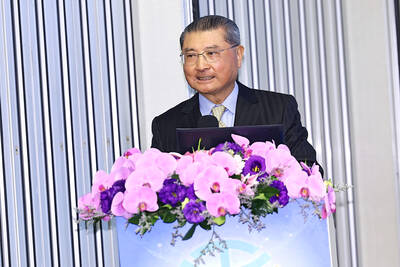South Korea’s early exports returned to growth for the first time in more than a year in another indication of recovering external demand that would offer some reassurance to investors and policymakers monitoring the health of global commerce.
Daily average shipments for the first 20 days of this month increased 8.6 percent from a year earlier in the first gain since September last year, data released yesterday from the Korea Customs Service showed.
The increase is a positive indication that world trade is starting to regain strength after a global slowdown and South Korea’s export figures are watched closely to get an early take on the trajectory of world trade.

Photo: Bloomberg
The gain is also an encouraging sign for the nation’s economy, given its heavy dependence on external demand to drive growth.
The trade report showed that total headline exports, which do not account for working-day differences, rose 4.6 percent from a year earlier for the 20 days this month, while imports increased 0.6 percent.
Exports to China fell 6.1 percent, for the smallest drop since summer last year, while those to the US increased 12.7 percent. Shipments to Japan rose 20 percent and those to Singapore soared 37.5 percent, the data showed.
Policymakers in Seoul have voiced hopes in the past few months that full-month exports would return to year-on-year increases before the end of the year. That would support stronger economic growth if it materializes as suggested by the early data for this month.
The sales of semiconductors, the biggest cash cow for the country, have also shown signs of bouncing back, especially NAND flash memory.
“In the end, the rebound in chip prices is leading the exports rebound,” Yuanta Securities Korea Co economist Jeong Won-il said. “We may see an odd economic situation of high growth, high rates and high inflation next year.”
In a separate report yesterday, the Bank of Korea highlighted the recovery in semiconductor demand and growing market optimism that it would continue to improve next year, citing the first increase in the price of DRAM in a year and a half last month.
South Korea sold US$5.2 billion in semiconductors over the first 20 days, 6.4 percent less than a year earlier. That is smaller than the 14.4 percent decline for the full month of last month, the trade report showed.

When an apartment comes up for rent in Germany’s big cities, hundreds of prospective tenants often queue down the street to view it, but the acute shortage of affordable housing is getting scant attention ahead of today’s snap general election. “Housing is one of the main problems for people, but nobody talks about it, nobody takes it seriously,” said Andreas Ibel, president of Build Europe, an association representing housing developers. Migration and the sluggish economy top the list of voters’ concerns, but analysts say housing policy fails to break through as returns on investment take time to register, making the

‘SILVER LINING’: Although the news caused TSMC to fall on the local market, an analyst said that as tariffs are not set to go into effect until April, there is still time for negotiations US President Donald Trump on Tuesday said that he would likely impose tariffs on semiconductor, automobile and pharmaceutical imports of about 25 percent, with an announcement coming as soon as April 2 in a move that would represent a dramatic widening of the US leader’s trade war. “I probably will tell you that on April 2, but it’ll be in the neighborhood of 25 percent,” Trump told reporters at his Mar-a-Lago club when asked about his plan for auto tariffs. Asked about similar levies on pharmaceutical drugs and semiconductors, the president said that “it’ll be 25 percent and higher, and it’ll

CHIP BOOM: Revenue for the semiconductor industry is set to reach US$1 trillion by 2032, opening up opportunities for the chip pacakging and testing company, it said ASE Technology Holding Co (日月光投控), the world’s largest provider of outsourced semiconductor assembly and test (OSAT) services, yesterday launched a new advanced manufacturing facility in Penang, Malaysia, aiming to meet growing demand for emerging technologies such as generative artificial intelligence (AI) applications. The US$300 million facility is a critical step in expanding ASE’s global footprint, offering an alternative for customers from the US, Europe, Japan, South Korea and China to assemble and test chips outside of Taiwan amid efforts to diversify supply chains. The plant, the company’s fifth in Malaysia, is part of a strategic expansion plan that would more than triple

Taiwanese artificial intelligence (AI) server makers are expected to make major investments in Texas in May after US President Donald Trump’s first 100 days in office and amid his rising tariff threats, Taiwan Electrical and Electronic Manufacturers’ Association (TEEMA, 台灣電子電機公會) chairman Richard Lee (李詩欽) said yesterday. The association led a delegation of seven AI server manufacturers to Washington, as well as the US states of California, Texas and New Mexico, to discuss land and tax issues, as Taiwanese firms speed up their production plans in the US with many of them seeing Texas as their top option for investment, Lee said. The